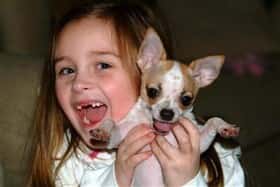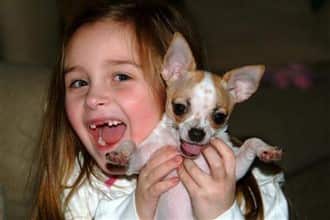Seniors
Senior Chihuahua Care
Overview
The top 10 elements seen with senior Chihuahuas and those that require adjustments in how you care for your dog are:
- A need for biannual wellness checks
- Decreased mobility and exercise tolerance
- Osteoarthritis
- Dietary needs and eating habits
- Possible weight gain
- Sleep changes
- Vision changes
- Hearing changes
- Weakening bladder and/or bowel control
- Skin and coat changes
This article will cover the age that a Chihuahua is considered to be a senior, dive into the details of these age-related aspects and offer tips on how to help keep your older Chihuahua happy, comfortable, and as healthy as possible.


Tia, an 11 year old senior Chihuahua, photo courtesy of Bonnie
The Age a Chihuahua Becomes a Senior
Though this is an important stage of life, there is no set age that all dogs or any one particular breed becomes a senior. Rather, a dog's age, current health status, breed size, and overall life span will be part of the equation.
Being in the toy breed class (which has an overall longer life span than larger breeds) and having a relatively long life expectancy
of 14 to 18 years, a Chihuahua is going to become a senior around the age of 10 years old, with a range between the ages of 9 and 12 years old.
Since dogs do not suddenly begin having age-related issues right on the mark of their birthday, owners should start to look at these aspects at the 8-year mark. This said, even if your Chi is already 10-years-old or in their teens, it is never too late to address these.
The Top 10 Changes to Expect with a Senior Chihuahua & How to Help
It is best to be prepared and aware of the most commonly seen challenges that senior Chihuahuas face at some point during this phase of life. Each dog is unique. These age-related changes can all develop in one year or more gradually over time. It is suggested to reassess things every few months to stay one step ahead and help keep your Chihuahua as happy, comfortable, and healthy as possible well into his or her teens.
#1 A Need for Biannual Wellness Checks
As opposed to the yearly wellness checks that adult dogs receive, seniors need to be seen twice per year. This holds true no matter how energetic or youthful a Chihuahua seems to be. Changes are occurring in the body and it is imperative that seniors are screened for issues that commonly affect older dogs.
Some of the health issues
that the veterinarian will testing for include liver and kidney disease, heart issues, prostate disease (for males), testicular cancer (for un-neutered males), breast and uterus cancer (for un-spayed females), canine diabetes, arthritis, and cognitive issues.
The goal is to catch issues early, which allows for the best possible prognosis. Each veterinarian has their own preferences; but, most like to begin these twice-per-year screenings at age 8.
#2 Decreased Mobility and Exercise Tolerance
What to know: Senior dogs have a general 'slowing down'; each year a Chihuahua will take a bit longer to rise, run a bit slower, and tire out a bit faster.
This is due to a combination of several elements: The body’s ability to turn protein into muscle decreases which leads to loss of muscle mass and strength. The body produces less glucosamine and chondroitin which can lead to stiff joints and other issues including osteoarthritis. In addition, all major organs gradually lose function, including the heart, which can cause a senior to reach his exercise limit faster than his younger counterparts.
What to do: The goal is to keep your Chihuahua active while being sensitive to an older dog's limits.
1)
Keep taking your Chihuahua for daily walks. Though pace should be adjusted according to ability, going for at least two daily walks each day will help in a number of ways. Exercise helps a dog maintain muscle mass, helps relieve the stiffness associated with arthritis by lubricating joints and reducing inflammation, helps keep the immune system strong, and helps ward off a range of disease including diabetes, heart disease, and some cancers.
2)
Make adjustments for full-day outings. If you're taking your Chihuahua out for the day, take frequent breaks for rest and rehydration. If there will be a lot of walking, consider a canine stroller or carry bag like the Bro'Bear i'Pet Small Dog Carry Sling
 which is designed for pets 12 pounds and under. If you'll be taking your senior to someone’s home for a full-day visit, bring along your dog's bed or cot and set up an area for your Chi to take naps.
which is designed for pets 12 pounds and under. If you'll be taking your senior to someone’s home for a full-day visit, bring along your dog's bed or cot and set up an area for your Chi to take naps.
3) Since seniors can have trouble climbing up and jumping down can put strain on ligaments and muscles, set up pet steps or ramps to help your senior access favorite resting spots like the sofa or your bed.
If you think your Chihuahua could use this sort of help, the Solvit PetSafe Pet Stairs for Small Dogs
 is a good option.
is a good option.
4) Seniors can have trouble with traction, slipping on both indoor floors and outdoor surfaces. To help with this, apply a paw wax once every two weeks. This will allow a senior to better navigate and has additional benefits such as keeping paw pad skin properly moisturized and helps repel allergens and irritants.
One of the best paw waxes for Chihuahuas of any age is Musher's Secret Paw Protection Wax ; this offers a breathable layer of protection and absorbs very quickly.
; this offers a breathable layer of protection and absorbs very quickly.
5)
Be proactive and reactive in regard to osteoarthritis; this is a condition that affects every single senior dog. Details are next.
Tax, a 10-year-old, long haired Chihuahua


Photo courtesy of John Cooker
#3 Osteoarthritis
What to know: Unfortunately, arthritis in seniors
is extremely common. In fact, by the age of 8 years old, 80% of canines will have some level of osteoarthritis.
There are some contributing factors. Dogs that have had luxating patella or other joint-related issues are more prone to develop arthritis in those areas (knees or hips). Weight plays a factor as well; the Chihuahua is not a breed that is prone to being overweight; however, some older adults and seniors may carry a few extra pounds. The more weight a joint must bear, the more stressed the joint becomes and the more susceptible it will be to damage.
Symptoms include less mobility, joint stiffness, weakness in one or more limb, and signs of discomfort.
What happens: Cartilage works as a cushion between bones, allowing the body to move fluidly and without pain. Two compounds that help keep that cartilage healthy, glucosamine and chondroitin, are produced less and less by the body as a dog ages. Decreasing levels lead to cartilage becoming thin and wearing down. When it does, bones start to rub together. This causes joint pain, stiffness, and inflammation. With progression, bones can become structurally damaged.
What to do:
1)
Have your senior Chihuahua screened for this. There are several prescribed treatment options including NSAIDs, steroids like prednisone, injections like Adequan, and even acupuncture and/or body manipulation via massage.
2)
Help with mobility by setting up pet steps near furniture as previously covered under Tip #2.
3)
Provide your senior an orthopedic (memory foam) canine bed. This will offer the proper support for bones and joints and warmth that helps loosen joints and relive stiffness. Details regarding beds are ahead under Tip #6.
4)
Since low to moderate exercise helps keeps joints loose and reduces inflammation, keep your dog active by taking at least two walks per day, at a pace that is comfortable for your particular dog.
5)
Offer daily supplements. With breeds like the Chihuahua that are prone to knee issues, this should be done starting at age 6 as a proactive step in helping to reduce joint issues in the future. Though, there will be benefits even if you get a late start on this.
There are two that can help with this common senior-related issue:
The first
is glucosamine and chondroitin with MSM and Coenzyme Q10 (CoQ10) which helps the body repair cartilage, balance fluid levels in the tissues that surround the joints, and send nutrients to the affected areas of cartilage via good blood flow. Once these benefits begin, there can be quite a bit of improvement in mobility and a decrease in discomfort.
For this, Doggie Dailies Advanced Hip and Joint Supplement
 is highly recommended. These are chicken-flavored soft chews that use a cold-press method to ensure maximum potency.
is highly recommended. These are chicken-flavored soft chews that use a cold-press method to ensure maximum potency.
The second
is an omega-3 fatty fish oil (DHA and EPA) which can help with pain and inflammation. In addition, fish oil supplements are fantastic to help keep both skin and coat healthy.
For this, Zesty Paws Pure Wild Alaskan Salmon Oil
 is a terrific choice. This is pure salmon oil preserved with a vitamin blend (shown as mixed tocopherals) and no additives at all. As a plus, this comes in a handy pump that allows you to easily add this to meals (be sure to mix it well) and most dogs find this to be delicious.
is a terrific choice. This is pure salmon oil preserved with a vitamin blend (shown as mixed tocopherals) and no additives at all. As a plus, this comes in a handy pump that allows you to easily add this to meals (be sure to mix it well) and most dogs find this to be delicious.
Little Squirt, at 10 year old senior Chihuahua


Photo courtesy of Rhea Lumsden
#4 Dietary Needs and Eating Habits
There are several elements to consider in regard to a senior Chihuahua's diet.
1. A Chihuahua may need to be switched to a senior dog food formula at the age of ten, but this is not necessarily a must. One of the main reasons for senior formula dog foods is to address the need for fewer calories to prevent obesity in older dogs something not seen too often with toy breeds. Senior formulas also tend to have more fiber to help with a sluggish digestive system and added extras like omegas, glucosamine and chondroitin.
However, if your Chihuahua likes their food and is doing good on it, you may be reluctant to make any changes, and that is okay in many cases.
If your Chihuahua is maintaining their weight, you are already offering senior supplements (see previous Tip #3, 'What to do' point 5), and you feel confident that the kibble is a top-quality brand, a change may not be warranted. In regard to fiber, seniors that tend to get constipated can be helped by adding bite-sized pieces of apple (no core, no seeds, no peel) or pumpkin (real pumpkin, not the pumpkin pie filling) to meals or giving this as snacks.
If you do decide to make a change to a senior formula, stick with the same brand, if possible. For example, if your Chihuahua has been eating Wellness CORE or Complete, there is a Wellness Complete Small Breed Senior Formula . If you change brands, do this in a gradual way over the course of several weeks, mixing the old and new food with a gradual move to new.
. If you change brands, do this in a gradual way over the course of several weeks, mixing the old and new food with a gradual move to new.
It should be noted that various health issues will dictate other changes in diet as well; for example a Chihuahua with kidney issues will be put on a lower protein diet.
2. Older dogs may resist eating hard kibble.
This breed is very prone to tooth decay, a reason why at-home dental care and regular veterinary dental exams are a must. But, even so, by the time a Chihuahua reaches the senior years the gums and/or teeth may be sore and/or there may be some tooth decay or even tooth loss that makes it difficult to crunch down on hard dog food.
Continue to have your Chi's teeth examined by the veterinarian, keep up with daily dental care, and make adjustments to food, if needed. Many owners are tempted to full switch to a wet canned food; however, other options are to add a bit of low-sodium chicken or beef broth and warm the food, soak the kibble in water for 10 minutes or so to allow it to be absorbed and warm the food, or do a 50/50 mixture of dry kibble and canned food (sticking with the same brand).
3. Seniors may eat less.
There are metabolic changes that occur as a dog ages. Adult dogs in their prime require approximately 40 calories per pound of body weight yet dogs well into their senior years may need only 33 or so. This is highly dependent on a dog's exact age, health status, and activity level.
As the metabolism slows down, a dog may automatically adjust and eat less. So, unless there is a dramatic change in appetite, and if your Chi is maintaining their weight, there is usually no reason to be alarmed.
Note that weight gain is covered up ahead.
#5 Possible Weight Gain
What to know: Though some seniors self-regulate their food intake to adjust to a lower metabolism, others stay in the habit of wanting to eat the same amount they did when younger. In addition to this, being less active when older, thereby burning off fewer calories, can lead to gradual weight gain, even for this very small toy breed.
What to do:
1)
There are body composition changes that occur with senior dogs. Less muscle mass can cause a dog's body to look out-of-shape and this does not necessarily mean that there is a weight problem. So, if you are unsure about this, have the veterinarian examine your Chihuahua.
2)
Since certain conditions like diabetes can cause weight gain, all possible health issues should be ruled out by the veterinarian.
3)
Gradually increase exercise if there are no health issues that would prevent this. Dogs of all ages
will benefit from at least two walks per day, so if your senior likes to nap and walks have somehow gone from two to one or none at all, it's time to start incorporating more time outside with this low-impact, health-boosting activity.
If you are already taking your senior for regular walks, try adding on 5 and then 10 minutes to each session.
4)
Offer low-calorie snacks. The food that we give to dogs in between meals can make up 20 to 30% of their daily calorie intake and this can really add up. A great option is to offer Fruitables Skinny Mini Dog Treats ; these are made-in-the-USA all-natural soft-baked treats with only 2 to 3 calories a piece and come in tasty flavors like pumpkin & mango, apple & bacon, and pumpkin & blueberry.
; these are made-in-the-USA all-natural soft-baked treats with only 2 to 3 calories a piece and come in tasty flavors like pumpkin & mango, apple & bacon, and pumpkin & blueberry.
5)
Offer lower calorie meals. You can replace some of the kibble with low calorie vegetables like green beans, cucumbers, kale, and spinach or make a switch to a kibble formulated for dogs that need to lose weight. This may be labeled as 'healthy weight', 'reduced fat', or 'light'.
One option for this is Wellness Complete Small Breed Healthy Weight ; this brand's entire line is top-quality made-in-the-USA food that is all-natural (no chemical preservatives or artificial flavors) and has no by-products or fillers.
; this brand's entire line is top-quality made-in-the-USA food that is all-natural (no chemical preservatives or artificial flavors) and has no by-products or fillers.
Peewee, from Dallas TX


Photo courtesy of Diva Taylor
#6 Sleep Changes
There is often a change in sleeping habits of senior Chihuahua dogs and it can seem quite tricky at times.
What to know:
1.
Adult Chihuahuas sleep approximately 12 to 14 hours in a 24-hour period (nighttime and naps). With seniors, there will be a gradual increase of needing to sleep more to rest both the body and the mind. In most cases, this will be seen with longer or more frequent naps.
2.
While there is
a need for more sleep, a dog's natural production of melatonin (which regulates sleeping patterns) slows as a dog ages which can lead to disrupted sleep at night (thus more naps during the day).
3.
Aches and pains associated with arthritis (seen with the majority of senior dogs; 80% to some degree) can greatly interfere with sleep.
4.
Older dogs tend to get chilly much more easily than their younger counterparts which also plays a role in their ability to get comfortable and ease into a deep sleep.
What to do:
1)
Have the veterinarian screen for arthritis and make changes as noted under Tip #3 point 5
such as offering joint supplements.
2)
Create a quiet area for your Chihuahua. Younger dogs often love to be right in the center of action and can sleep through just about anything. But, senior dogs appreciate a quiet area that they can retreat to with less noise and commotion. This said, older dogs do not like to feel isolated.
Find a good balance by having your Chi's resting area in a room that is used by the family but in a corner without foot traffic or near the TV, etc.
3)
Offer a quality orthopedic bed. All senior dogs, even those that seem to enjoy resting on the floor, should have a memory foam mattress or bed. This is crucial to provide proper support for joints and to give a dog's entire body the right surface to rest and rejuvenate from the day's activity.
If your senior Chihuahua does not yet have an orthopedic bed, you may want to consider one like the Friends Forever Premium Memory Foam Dog Bed .
.
#7 Vision Changes
There are several changes related to the eyes to be aware of.
1. There may be clouding of the eye lens due to one of two very different causes:
- Nuclear sclerosis, also known as lenticular sclerosis, is a very common age-related condition with dogs that may begin early at the age of 7, gradually worsens with age, and is most often noticed by owners by age 10 or 11. This type of clouding generally does not interfere with a dog's vision. These may have a blue tint.
- Cataracts, seen most commonly with dogs age 8+ years, is a progressive eye disorder that can interfere with vision and in some cases lead to blindness. These generally have an opaque or white tint to them.
2. Whether due to cataracts or normal age-related reduced senses, older dogs can have trouble seeing as they once did.
Signs of vision impairment include general clumsiness (bumping into walls and furniture), startling easily, apprehensive behavior, inability to easily find toys, and/or reluctance to go out at night.
What to do:
1)
If you notice any clouding to your Chihuahua's eye(s) or vision issues, it is imperative to have the veterinarian determine the cause.
2)
Do not make changes to the layout of furniture in the home.
3)
Do not change walking routes.
4)
Approach your senior from the side and at his level, as not to startle him.
5)
Gate off any staircases that may present a falling hazard.
Vinnie, at 11 years old


Photo courtesy of Gordon Chamberlin
#8 Hearing Changes
What to know: Seniors may have reduced hearing to some degree in one or both ears and this can be difficult to address since dogs rely so much on this sense. Signs to look for include not responding when called and/or acting startled when you approach or wake your dog.
Other issues can mimic age-related hearing loss, including excessive wax buildup or a foreign body in the ear.
What to do: If there is age-related hearing loss, it cannot be reversed; however, there are steps that you can take to help your senior deal with this.
1)
Flip on light switches before you enter a room.
2)
If you need to wake your senior, do so by first holding your hand in front of his nose, then gently touching his back.
3)
Give physical praise (petting) as opposed to verbal praise.
4)
Start to incorporate hand signals for common commands.
#9 Weakening Bladder and/or Bowel Control
What to know: Loss of bladder or bowel control, known as incontinence, is most commonly seen with dogs age 11 and up. In many cases, it is a natural sign of aging; however, there are some health issues that can cause this such as a urinary tract infection, bladder infection and or hip issues.
What to do:
1)
Have this diagnosed by the veterinarian to rule out possible health issues.
2) Bring your Chihuahua the designated bathroom area more often.
3)
Allow more time for bowel movements.
4)
If an older dog tends to have problems late at night or in the middle of the night, offer the last evening meal at an earlier time.
5) If accidents are occurring frequently, consider keeping your Chihuahua in a defined area that is easy to clean. A canine playpen like the IRIS 24'' 4-Panel Pet Playpen with a Door lined with pee pads, can work very well. Note that is your Chi is on the larger size (over 10 pounds) or has proven themselves to be a good jumper, the 34" option may work best.
6)
Consider doggie diapers. While owners may feel that a dog may be embarrassed to wear these, for older dogs that are aware of their accidents, wearing a diaper can actually preserve self-esteem.
Angel, a rescue dog estimated to be 9.5 years old


Photo courtesy of JC Rivera
#10 Skin and Coat Changes
What happens:
This breed is already prone to skin sensitivity, but with older age this is even more pronounced. In addition, as a dog ages, the epidermis (the surface layer of the skin) becomes thinner, which causes skin to become more fragile and more prone to dryness, irritation, rashes, and/or itching.
The paws and nose can become overly dry, which can be quite uncomfortable and eventually lead to peeling or cracking.
Skin and coat often go hand-in-hand, so issues you may start to see can carry over onto the coat; you may notice hairs are dull or have less-than-ideal texture.
What to do:
1)
If you are not already, use high-quality coat products that are geared towards sensitive skin and protecting and correcting issues like dryness and itching.
For this, Earthbath Oatmeal & Aloe Shampoo with Vanilla & Almond
 is always a great choice for a shampoo and their accompanying conditioner is also ideal.
is always a great choice for a shampoo and their accompanying conditioner is also ideal.
2)
Paws should be protected year-round with a quality paw wax. This will help a dog tolerate both hot and cold walking surfaces, repel small sand and debris, repel allergens and contact irritants, help with traction, and keep paw skin moisturized and in good shape.
For this, Mushers Secret Paw Protection Wax
 is a top choice and is applied once every two weeks.
is a top choice and is applied once every two weeks.
3)
The nose should be protected with a soothing nose butter. This will keep the nose skin in good shape and help prevent from chapping, drying, peeling, and other common issues.
For this, Natural Dog Company's Snout Soother Nose Balm
 is very effective and only needs to be dabbed on once a week.
is very effective and only needs to be dabbed on once a week.
4)
An omega-3 EPA and DHA supplement which you may already be giving for joint issues, see previous tip #3, point 5, will help improve skin and coat health as well.
A Final Thought and Summary
It's not always easy watching our canine family members age so much faster than us humans. And while we cannot slow down time, there certainly are steps we can take to keep our senior Chihuahuas as comfortable and healthy as possible. This is what we all signed up for; from puppy to adult and finally to senior, it is our responsibility to offer specialized care for each phase of our dog's life.
You may also be interested in:
Bringing a Chihuahua Outside in Bad Weather
- For rain, snow, or extreme cold, see great tips for helping a Chihuahua tolerate outdoor walks and bathroom needs.
When a Chihuahua Forgets Housebreaking Rules
- Did you Chi suddenly forget the rules that they seemed to know very well? If so, it may be time for a reset with an emphasis on the most important aspects house training.
Chihuahua Care
- A good overview of everything that is needed to take great care of your puppy or dog.
When a Chihuahua Marks in the House
- If your guy or gal is peeing all over the house, it may be territorial marking. Learn what triggers this and how to make this stop as quickly as possible.
Chihuahua Allergies
- This covers contact, seasonal and food allergies that typically affect Chihuahuas. Signs and treatment.
We are a participant in the Amazon Services LLC Associates Program, an affiliate advertising program designed to provide a means for us to earn fees by linking to Amazon.com and affiliated sites.
Email: Contact@PetChiDog.com
